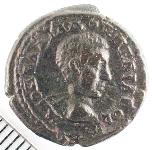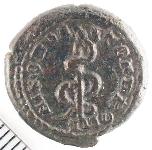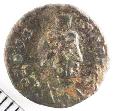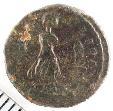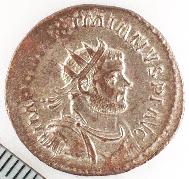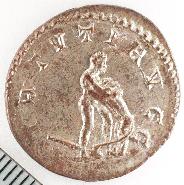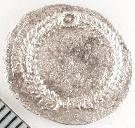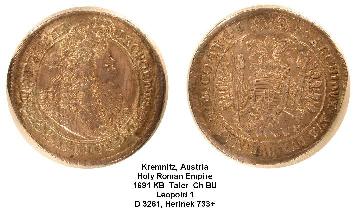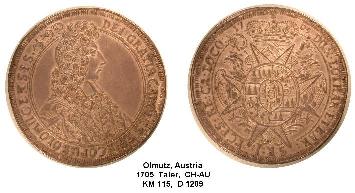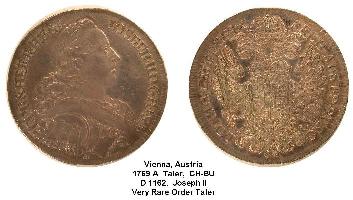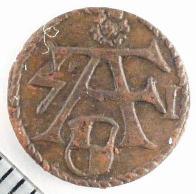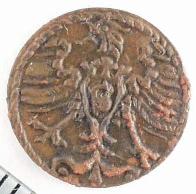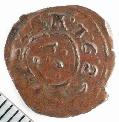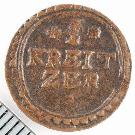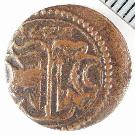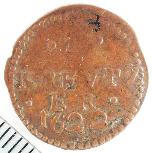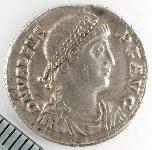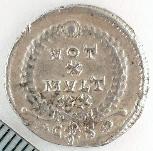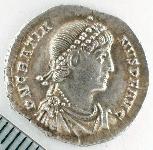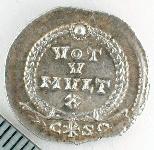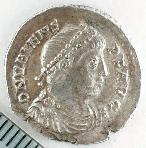Chatter
archive
also available
| Chicago Coin Club |
|---|
| Volume 48 No. 8 |
August 2002 |
|---|
Minutes of the 1002nd Meeting
President Carl Wolf called the 1002nd meeting of the Chicago Coin Club to
order on June 12, 2002 at 7:02PM. The meeting was held at 1 Bank One Plaza.
A motion was made, seconded and passed to approve the May
meeting minutes as they appeared in the Chatter.
Secretary/Treasurer Lyle Daly gave a treasury report as follows:
| Dreyfus Money Market |
$1845.38 |
| Bank One CD |
1437.59 |
| Bank One CD |
1435.72 |
| TCF Checking Account |
2393.41 |
| Un-deposited Funds |
44.00 |
| TOTAL |
$7,156.10 |
Two guests were present: William Riles and Steve Norton.
Vice President Bob Feiler noted that member Andy Plioplyus will speak at
the July meeting. James McCormick will speak at the September meeting. No
speaker is yet scheduled for the October meeting. Bob introduced club
member Mark Wieclaw and cited his laudatory numismatic credentials. Mark's
topic was "Perspectives on Numismatics".
Mark offered his perspective on our hobby as a collector, exhibitor, club
officer, show director and as a coin dealer.
Mark became interested in collecting after looking at his father in law's
collection. Mark handled the liquidation of that collection after his
Father in law passed away and urged collectors to organize their specimens
and collect quality rather than quantity. Mark relayed the pleasure we
derive from showing our collections and the camaraderie we experience when
traveling to shows with fellow collectors. Many publications are available
today and hobbyists should make use of them. Mark was a faithful reader -
cover to cover - of many, but today finds them somewhat repetitive and
focusing on how good or bad the US Mint is doing it's job.
As an exhibitor, Mark was awarded the 1998 Best of Show in Michigan. Mark
noted that this was certainly a prized achievement, but the pleasure must
be in the showing. It is difficult to achieve a common basis for judging,
as qualified judges may not be available at all shows. As with any
institution/group, politics also enters into decision-making. Mark cited
examples of first hand experience in judging that were in conflict with his
understanding of the criteria.
Memberships in clubs are wonderful opportunities to share your hobby. It is
a forum in which to learn and exchange material. Mark shared his thoughts
on club leadership as a way to "give back" to the hobby and suggested that
resume building would be a poor reason to hold office and detrimental to
the organization.
Coin shows are a challenge to organize. Mark worked extensively on the
Illinois Numismatic Association shows. He spent significant time and effort
in relocating this show from Peoria to Chicago with the belief that more
people would attend if it were in Chicago. His experience was that ballroom
rentals were twice as expensive. Catering and hospitality costs were
unbelievable. Dealers tended not to participate as a result. Most clubs do
host coin shows. The Chicago Coin Club is one of the few that does not.
Mark is a coin dealer. That is his livelihood. Collectors should be mindful
that dealers are not hobbyists when they are at work. They need to make a
profit. The time a dealer spends with a customer is an investment. Mark
suggested that haggling over price should be done with class and avoided on
the $2 and $3 items. Most dealers prefer transactions in cash. If you are
selling to a dealer, Mark suggested that if you intend to sell, sell to a
small enterprise. Have the material organized and inventoried so the more
valuable material can be easily identified. The time it takes a dealer to
organize a potential purchase is a real cost to the dealer. If you are
purchasing material, be cautious of prices realized in auction. These are
easily inflated.
Some of Marks favorite lines from customers are: "I have a penny with
Lincoln and Kennedy on it. Is it rare?" "I have a buffalo Nickel in Mint
State with no date on it." "What should I buy?" "Will gold go up?"
Vice President Bob Feiler thanked Mark for his presentation and awarded the
featured speakers medal & and the educational certificate to him.
Second Vice President Don Dool announced there were 9 show & tell
presenters:
-
Bob Weinstein - Several Scythian coins from 30BC to 5AD
-
Bob Feiler - Civil War bond, $2 State of Indiana Note, 1837 Trust
Certificate, Microscopic Photo
-
Lyle Daly - Rochester Numismatic Association Medal
-
Carl Wolf - African Trade Beads
-
Mike Metras - His new book on CD, Travels of a Youth & Mike's military
drivers license signed by fellow member Steve Zitowsky
-
Mark Weiclaw - Buffalo nickel pop out, gold eagle w/ planchet flaw, 3
ancient double strikes.
-
Sharon Blocker - South African 1Rand, Novelty note, Aruba coinage &
photos of the Aruba currency museum and catsup bottle labeled
"sunscreen for French fries"
-
Don Dool - Discount card Ben Franklin stores, Furth & Campbell site
draft, and scrap from counterfeiting operation.
Reading of Applications for Membership:
There were no first readings for membership.
The following candidates for membership had their names read for a second
time: Steve Norton and Thomas Pupp. A motion was made, seconded and passed
to approve their membership. (Writer notes that Thomas Pupp was actually
approved for membership at the 1001st meeting.)
Carl Wolf reported that he referred the life membership application of
Michael Brodsky to the life membership and that Mike's application was
approved.
Old Business:
Mark Wieclaw presented to the club archives, the silver 1000th
meeting medal #1, the "gold select" medal #100 and the lead trial strike.
Mark also noted that a Gold Medal from the 1000th meeting is available for
approximately $2,700. Also available are medals from the 80th anniversary
of the Chicago Coin Club.
New Business:
The ANA will present a 90 Year Membership Certificate to the CCC at the New
York convention. Robert Leonard will be present and will accept on behalf
of the club.
Paul Hybert announced that he is no longer associated with the University
but will have access to his email for several months. Consequently he asked
that all materials sent to him for publication in the Chatter be submitted
in TEXT format.
Lyle Daly reviewed the club mail and noted a letter regarding a Texas coin
dealer, Brent Bogus and difficulties that a customer was experiencing with
that dealer. The letter is available for further review by members.
It was noted that dealer David Lawrence and member Howard Eisenberg passed
away.
The meeting was adjourned at 9:10 p.m.
Respectfully submitted by Lyle Daly
Minutes of the 1003rd Meeting
President Carl Wolf called the 1003rd meeting of the Chicago Coin Club to order on July 10, 2002 at
7:04PM. The meeting was held at 1 Bank One Plaza.
The June meeting minutes did not appear in the Chatter. Approval of the minutes was defered until next
month.
Secretary/Treasurer Lyle Daly gave a treasury report as follows:
| Dreyfus Money Market |
$1852.43 |
| Bank One CD |
1437.59 |
| Bank One CD |
1435.72 |
| TCF Checking Account |
2165.01 |
| Un-deposited Funds |
108.03 |
| TOTAL |
$6,999.05 |
One guest was present: William Riles.
Second Vice President Don Dool introduced club member Audrius Plioplys MD, known to fellow members
as Andy Plioplys. Don cited Andy's numerous interests and credentials. Andy's topic was Lithuanian
Banknote Proofs from the 1920s.
The notes in Andy's collection were purchased from a broker by an elderly friend of Andy's. The notes
were found in the wall of an office building, in a brief case. Andy discussed the history of Lithuania and
it's fluctuating borders, focusing on the period around World War I.
Prior to the hyperinflation of 1922, Lithuania's currency was linked to the German Mark but switched to
the US dollar. The interim notes for this transition were printed in Germany. The permanent notes were
printed in Czechoslovakia in 1, 2, 5, 10, and 20 centas and 1, 2, 5, 10, 50 and 100 Litas. Beginning in 1925
coinage for centas began to circulate and the notes rapidly disappeared from circulation.
Andy presented some original paste up art from the plates for centas. Andy speculated on the origin of the
collection. It is unlikely that it was a presentation portfolio as it contained mirror image prints, examples
printed on cigarette paper and items of "poor quality". Andy proposed that this was from the Bank of Trade
& Commerce in Vilnius. The Minister of Finance, Petrulis, was the funnel for the notes from
Czechoslovakia to the Lithuanian government. The Minister was president of the Bank of Trade &
Commerce when it failed. It is known that he served prison time as a result. It is possible that he had the
opportunity and motive to hide this collection during the 1920's in hopes of retrieving it
later. The minister was executed in Siberia.
Don Dool thanked Andy for his presentation and awarded the featured speaker's medal and the
educational certificate to him.
Second Vice President Don Dool announced there were 11 show & tell presenters:
-
Sharon Blocker - Savings and Loan Exonomia and a Antarctica $2 Note
-
Mark Weiclaw - 4 ancient coins , one purchased from Thom Bray, star of Riptide
-
Bob Weinstein - 3 Coins of Constantinople
-
Alex Basok - 2 Soviet coins on off metal planchets
-
Terry Capps - Federal Reserve Star Notes from circulation
-
Carl Wolf - Article on decorating with primitive money, cross money
-
Robert Leonard - Numismatic literature.
-
Steve Huber - Several Thalers and commemorative pieces
-
Jeff Rosinia - Alaskan gold rush information and gold dust from his trip to Alaska
-
Lyle Daly - FRN Star notes, circulation finds and metal detection results from his lawn
-
Don Dool - four coins and an article by Don in a South American Coin publication.
Reading of Applications for Membership:
There was one reading for membership. William Riles had his name read for the first time.
Old Business:
The ANA will present a 90 Year Membership Certificate to the CCC at the New York convention. Robert
Leonard will be present and will accept on behalf of the club.
New Business:
President Carl Wolf noted that a small group reviewed the contents of the safe deposit box. This group will
recommend to the board what material will be kept and what unrelated material and duplicate material
should be placed in the November Auction.
President Carl Wolf also advised membership that a board meeting will be held prior to our August
meeting.
Members were advised that club memorabilia will be available in the Stacks July 17th auction.
Members were advised of a burglary at Westlake Cards Comics and Coins in Glendale.
The meeting was adjourned at 9:10 p.m.
Respectfully submitted by Lyle Daly
Speaker's Wor[l]d
Lithuanian Banknote Proofs from the 1920s
Presented by
Audrius Plioplys
to our July 10, 2002 meeting.
Are you shocked, shocked by the current financial scandals and troubles?
Need a break?
Then read on to learn about Lithuania's financial troubles in the 1920s,
along with some numismatic relics of that period.
Six years ago, Andrius bought a group of apparent Lithuanian bank notes
from a man in Toronto,
who had obtained them from a man in Kaunus, Lithuania.
Allegedly found during the remodelling of an old building,
most details are known only to those directly involved and they are not talking.
Andrius could not obtain the identity of the building in Kaunus,
but his research led him to the start of independent Lithuania's
financial system and the figure of Vytautas Petrulis (1890-1942).
Prior to independence, the circulating currency was denominated in a non-native
mixture of rubles and marks.
Lithuania gained its independence from Russia on February 16, 1918,
following Russia's collapse after surrendering to Germany in WW I.
Loan agreements with German banks guaranteed continued use of "ost-marks" (tied
to the German mark) as the official currency.
Among examples Andrius showed were 1 and 3 ruble notes,
and 2 and 5 mark notes.
Following Poland's 1920 invasion and occupation of much territory,
including the capital Vilnus,
bank notes were issued in the Polish language.
The units of account were the first to acquire local names;
from January 1920, all accounting used auksinas
(instead of mark, ost-mark, and ruble) and statikas
(instead of pfennig and kapeika).
However, no money was issued in those denominations,
and cent replaced statikas in 1922.
In spite of the local names,
the Lithuanian system still was tied to the German mark,
and the German inflation and then hyper-inflation took its toll.
A new currency was introduced on August 9, 1922,
with the litas equal in value to 0.15 grams of gold
(or one U.S. dime).
The Bank of Lithuania was established on August 11, 1922,
and was allowed to print paper money for 20 years.
The four members of its board of directors put up capital
of 12,000,000 litas.
The first bank notes were hastily printed in Berlin,
with the contract signed on August 30 and note delivery on September 20.
Very primitive, these notes were issued in denominations of 1, 20, and 50 cent,
and 1 and 5 litas.
More permanent bank notes were made by Andreas Haase Lithographic Printers
of Prague, under a contract of August 29, 1922.
The cent denominated pieces (1, 2, 5, 10, 20, and 50) used standard designs
and backgrounds, but the litas denominated pieces (1, 2, 5, 10, 50, and 100)
used designs overseen by the bank.
Cent notes were issued November 16, 1922, in series A, B, C, and most
letters of the alphabet.
The designs of the litas notes reflect their importance relative to the
subsidiary cent notes;
serial numbers, more signatures, and reference to their gold value.
But sometimes the temptation is too great,
and Andrius explained that the portrait of Gedimas (a medieval Lithuanian
historical figure) on the 50 litas note is actually of the artist who
designed the notes in Prague.
A 1924 issue was printed by Bradbury Wilkinson,
and the first coinage was introduced in 1925.
But it is the Prague notes that are central to this story.
Andrius showed many pieces from the hoard;
all were cent denominated, but they were not of the regular issue,
being of varied quality, printed on various paper, and in varied formats.
The first hoard item was of the 1 cent design with paste downs of signatures;
followed by similar examples of the 2 cent and 5 cent notes.
Andrius could not determine whether the pieces were printed or hand drawn.
(Unless stated otherwise, each of the displayed pieces was a uniface
example of series A.)
Andrius showed many 1 cent notes,
using different printing inks and different backgrounds.
Since these used neither the ink nor background of the official notes,
you may wonder, "What are they?"
Andrius' and the members' opinions on that waited
until more pieces from all of the cent denominations were shown.
(First present the evidence, then present a theory.)
Among the more than 20 2 cent notes shown,
two pieces were odd even for this group.
The "mirror image" note was produced by introducing paper
between the original and transfer rollers.
The 2 centai (plural form) denomination rather than
the 2 centu (two form) points out an interesting aspect
of the Lithuanian language;
in addition to the singular and plural forms of nouns,
there also is a "two form."
The 5 cent notes had many oddities;
thin paper (tissue or cigarette paper), mirrors in many different colors,
and a generally poor quality.
Only one 10 cent note was shown, a proof.
The 20 cent notes included heavy card stock and large size (large borders)
in addition to more of the thin paper and poor quality.
Also, these were of series E and H instead of the typical series A.
Completing the individual pieces,
the one 50 cent note was printed on thin paper.
But the hoard contained a few more pieces;
a block of a 5, 10, 20, and 50 (with each note in a different color),
and then a block of four different reverses.
Andrius knows neither the condition nor arrangement when the hoard was found,
but hinge remnants on some pieces indicate some effort at collecting
or organizing.
It is known that about 20 sets of proof notes had been produced and
distributed to legislators, but the poor hoard quality prevents our
identifying the hoard as one of those sets.
Also, the hand written notes (of printing terms)
in Czech and German imply "working" copies.
Having examined the hoard, what could we make of it?
Andrius' opinion is that the hoard came from a government building in Kaunus,
most likely the Bank of Lithuania which was built from 1925 to 1928.
Vytautas Petrulis, as Minister of Finance, had signed the contracts for
the Berlin and Prague print jobs, and the official proof books had been
delivered to him.
It would have been very easy for him to have asked for "extras,"
or maybe the printers gave him items to smooth things.
Petrulis was a director of a bank in Klaipeda from 1919 to 1922,
and during the summer of 1922 he was very vocal in supporting
the establishment of Lithuania's own currency.
In addition to serving as Finance Minister from August 1, 1922
to September 25, 1925,
he also was Prime Minister for most of 1925.
He is considered the father of the litas,
and was an important man whom people trusted and would try to please.
But in 1925 the Klaipeda bank went bankrupt,
and charges were placed when it was discovered that the Finance Ministry
had kept funds in that bank.
After serving one and a half years in jail, he retired to his dairy farm;
after the Soviet invasion, he was sent to Siberia and shot.
Andrius believes that the hoard was hidden in 1925,
before Petrulis' conviction and disgrace.
After his conviction, Petrulis no longer had full
and easy access to the building.
Alex Basok started the members' comments with a brief overview of
the paper money design process.
At each of many steps, from artist's conception to final product,
proofs are made;
there are artist's proofs, printer's proofs, and color proofs.
He believes that the Minister asked the printers for everything,
and thinks that the site of the hoard was the Ministry of Finance.
Other members also contributed thoughts and theories,
and Andrius concluded the program by noting that similar
"unique" and strange items are appearing on eBay.
Show and Tell
Most images have a scale in the lower-left corner,
with the tics spaced 1 mm apart.
Because the brightness and contrast were manipulated on a computer,
the coloring of a coin's image differs from the coin's actual coloring.
-
Sharon Blocker
started the evening's program with varied items:
-
Exonumia from Savings & Loans,
including:
an Indian Head cent set,
an ash tray with 5 Lincoln cents,
and an ice cube tray from Columbus Federal S & L.
-
A U.S. mint medal.
-
$1 and $2 paper money of the Antartic Overseas Exchange Office Ltd.,
from 1999.
-
Mark Wieclaw
showed some ancient Roman coins:
-
A provincial coin of Diadumenian as Caesar (217-218 AD) from Moesia Inferior.
-
A denarius of Maximinus (235-238 AD) with
a bust of Serapis on the obverse,
while the reverse shows Ises sailing to the Pharos lighthouse,
which is the same design as used hundreds of years earlier on
an Alexandrian piece.
-
A silvered coin from Antioch during the time of Maximinus II, 309-313 AD,
with Hercules strangling a lion on the reverse.
This coin was bought at CICF from dealer Thom Bray
who was in the TV show Rip Tide years ago;
Thom still writes some screenplays.
-
A half siliqua from the time of Constantine,
with a star on obverse and wreath on reverse.
(See Bob Weinstain's exhibits for similar pieces.)
-
Bob Weinstein
showed three votive issues.
Votive issues refer to vows originally taken every 10 years,
but later shortened to 5 years; on anniversary of rule.
This was issued by Valens (364-378) who was a brother of Valentinian.
It honors 10 years, and hopefully 20 (hence the X and XX).
-
-
A votive coin by Gratian, for 5 years and hopefully 10.
-
A votive coin by Valen,
thought to be a "for military" issue due to the M
after the CON mintmark for Constantinople.
-
Alex Basok
showed two wrong-metal coins:
-
A 1988 5 kopeck coin from the Soviet Union.
Not only struck in copper-nickel instead of brass,
close examination revealed signs of the underlying 50 kopeck coin.
-
A previously unknown 1915 2 kopeck coin struck in steel.
Given as a gift ten years ago in London,
people did not know what is was.
The same reeding count and shape as on the circulating brass pieces
indicate this coin was struck from original dies.
Researching the coin while at the Hermitage led nowhere,
until an archive director remembered a note about "bringing
seven steel coins" between departments;
seven was the number of brass coin types.
-
Terry Capps
recounted his recent finds of U.S. star notes from circulation.
After receiving a $1 star note in change at a chocolate shop,
and wondering how to get it home unfolded,
he asked the cashier and now has some consecutively numbered
$1 star notes.
He also recently received $5 and $20 star notes.
-
Carl Wolf
continued his exhibiting theme of primitive money with:
-
An article from the Wall Street Journal about the CEO of eLaw Forum.
The accompanying photograph showed an office decorated with primitive African money.
-
An H-shaped copper ingot from Zimbabwe.
Not much informationon primitive money is found in coin books,
but some numismatic information is presented as part of a larger work.
For instance, the Red Gold of Africa is about copper,
but it has line drawings of numismatic items.
-
One of
Bob Leonard's
current interests is California Gold.
The standard references in that area include the Menjou Catalogue,
the Breen-Gillio book, and the Jay Roe book;
but they contain some errors and lack the information learned
since their publication.
Bob showed marked-up copies of those references with notable provenances:
inscribed to A. Kosoff from Ed Lee,
the New Netherlands office copy,
from Ron Gillio's library,
from Walter Breen's library,
and from the Bass library sale.
Each had many notes or clippings.
For the specialist, there is no such thing as "too many copies"
of a book.
-
Steve Huber
is dedicated to photographing his coins.
Among the large silver pieces shown were:
-
1691 Kremnitz. Leopold I on obverse.
-
1705 Olmutz. Duke of Lorraine on obverse.
-
1725 Hall mint, Austria. The only wear is on the cheek bulge.
-
1760 Salzburg. Sigismund III on obverse, and St. Rupert
seated with Madonna and child on reverse.
-
1769 Vienna. Order Thaler of Joseph II,
acquired from the Goodman sale.
-
1928 Salzburg.
Honoring the 300th anniversary of the cathedral,
the reverse design features the cathedral and is from 1628.
-
1918 Eritrea.
A provo talero,
listed as a pattern by Krause.
-
Jeff Rosinia
brought some souvenirs from his trip to Alaska.
The Ace Hardware store in Skagway had five sizes of pans,
so he bought one, went out to a creek,
and showed us the resulting few flakes in a vial.
-
Lyle Daly
showed some recent finds:
-
Four $1 star notes from Wendy's;
series 1999 and consecutively numbered.
-
From rolls of cents,
a 1919-S and a 1973-S with a lamination.
-
A survey of his 6,000 square foot lot with a borrowed metal detector
turned up some junk metal and 91 Lincoln cents.
-
Don Dool
continued some of his favorite themes:
-
1571 pfennig of Brandenburg in Franconia (northern Bavaria).
Struck under Albrecht Friedrich (1569-1618).
Purchased from Alex Basok at CICF,
x-ray analysis showed enough silver to qualify as billon.
-
1621 flitter of Einbeck.
Einbeck is a small city in
Lower Saxony that "grew up around the monastery of St. Alexander." It
was first recorded as a town in 1274. It was a member of the Hanseatic
League and had its own local coinage from sometime before 1504 until
about 1691.
-
1622 kreuzer of Bistum of Augsburg.
This see was founded around
887 by Bishop Adelbero von Dillingen and coinage began sometime in the
middle of the tenth century. In 1807 the bishopric was secularized and
became part of Bavaria. This coin was minted during the administration
of Heinrich V von Knoeringen.
-
1622 kreuzer of Chur Pfalz.
Chur Pfalz is also referred to as Pfalz,
Kurlinie and the Rhenish Palatinate. The first mention of the Count
Palatine of the Rhine, the highest imperial representative in the area,
was in the tenth century. This electoral post was held from 1610 to 1623
by Friedrich V, the "Winter King" of Bohemia.
-
In the mail from Buenos Aires was a numismatic bulletin
with one of Don's articles (translated into Spanish).
2002 ANA Summer Seminar
By Mike Metras
mike@worksandwords.com
"Where do you wanna start. I don'know. You tell me. It's your auction,"
Sonny Henry begins another item at the American Numismatic Association's
(ANA) Summer Seminar Young Numismatist (YN) Scholarship Benefit Auction.
A highlight of every summer seminar, the two-session auction, where
bidders pay outlandish prices for donated items that this year included
President John Wilson's sweat shirt, brought in over $17,000 to be used
for YN scholarships to next year's seminar. A $1,000 bottle of water
highlighted three hours of fun and laughter Wednesday evening.
Checking in the previous Saturday morning, I headed for my brand new
Colorado College dorm room. My friend Rich and I shared a room with two
others. Rather, I should say we each had a separate sleeping room that
adjoined a cathedral-ceilinged, living and cable-TV room, kitchen, and
bath quad complex. Fans and crosswinds compensated well for the lack of
air conditioning. Nice digs. No wonder college costs more these days.
This was my eighth seminar in nine years, I knew the routine. Renewing a
lot of old acquaintances, the impressive Colorado Springs coin show,
welcoming speeches, a concert by the Doe Brothers, and the ANA Library's
book sale filled Saturday afternoon and evening and Sunday morning as we
waited for classes to begin Sunday at one. The library uses the captive
audience to sell off extra books it accumulates over the year. Some
leave with full boxes of books while others with one or two special
goodies at rock-bottom prices.
This year Rich and I took a class on Asian Coins. Others took classes on
grading, US copper coins, Mexican coins, English coins, Ancient coins in
various flavors, Military currency, and a number of others, 30 different
ones in all. The 200-plus students study one basic topic for the week.
George Fisher and Bill Spengler told eight of us more than we could
begin to retain about Chinese, Indo-Greek, Parthian, Ashokan, Korean,
Islamic, and Indian coins of all times. Among so many others, they told
us of coins of the generals of Alexander the Great, of ancient Chinese
dynasties, of the Sultan of Thousand and One Nights, of Marco Polo, and of
Genghis Khan. Ken Bressett made a cameo appearance to talk about Chinese
struck coins. Joe Boling followed to tell us of Japanese coins.
The class was a marvelous overview with many wonderful examples to
fondle. But in the end, the amount of information was overwhelming to
the point that we went away with little more than lists of names and
places and countries and rulers. I wouldn't have missed it for anything,
but at the same time it could have easily been three separate classes.
They have had it as two classes before. But there is the little matter
of interest. This was at least the third or fourth year I had tried for
the Chinese class and the third for the Islamic. All were canceled. As
it was, this time our class of eight was divided down the center in
interest - if the classes had been separate, four of us would have signed
up for Chinese and four for Islamic - and neither class would have
happened because a class requires five or it is canceled.
In addition to the main seminars, "mini" seminars provided additional
chances to learn. Among others, using Gallery Mint Museum equipment,
Ron Landis and Joe Rust taught how mint errors happen in their Creative
Error seminar. Students made all kinds of errors. And Susan Nulty of the
ANA MIS department demonstrated their state-of-the-art image scanning
and photographing equipment. I attended the latter and learned how Susan
scans 14 bills of the Bass collection at a time at 5,240 dots per inch
resolution on a high-end, state-of-the-art, flat-bed scanner. The aim is
to have a full library of electronic images of the collection. Then,
using an electronic studio camera, I took an image of a Chinese ten cash
coin at the same resolution. I don't know what I'd ever use such a high
resolution image for (other than forensics), but I was impressed. The
equipment, valued in the high six digits, is on loan to the ANA at no
cost to them. They also use the images to produce museum-quality prints.
An outside company makes very high quality, photo-electronic prints at
$15 a square foot, a very reasonable price when you realize that, that
is only $90 for a 24" by 36" print.
When all planned activities were over each day, we whiled away the
evenings sitting and talking on the veranda making and renewing
friendships that last a long time after the week is over.
A gala banquet and awards ceremony ended it all Thursday evening. By
breakfast the next morning, the college cafeteria (our eating and
meeting place) was already devoid of many now-familiar faces. The party
was over.
As others left for the airport to return to their regular lives, I
headed for a week in the Colorado mountains where I walked up canyons
and down trails. First stop, thanks to a bull session by Dave Jaeger
Monday night on "From Mine to Mill to Mint" about Colorado mining, was a
metal detector shop in Golden where I bought a gold pan. Next stop, a
promising place on the river along Route 6. I walked away a couple hours
later with an aching back and a few flakes of gold in my bottle. And I
had totally convinced myself that making a living that way could be
rather backbreaking!
I walked miles in Glenwood Canyon and environs. Then I headed upland
where the trickster, the coyote, visited me twice and chipmunks climbed
my leg begging peanuts from me as I sat reading under evergreens on a
remote mountain top far from the mass of civilization. The days were hot
and dry and the nights cool. Every afternoon brought clouds and thunder
and lighting and wind but only drops of rain. The drought continued but,
no, all of Colorado was not on fire.
All too soon I was back home tired and relaxed and already looking
forward to another week in Colorado next year. Lest you think this is
all there is to the seminar, I have left out more than I told. My story
is only enough to entice you into thinking seriously about attending
some time, maybe next year. It costs less than a comparable week in
almost any other vacation destination you can think of. Check it out at
www.money.org or read details about the earlier seminars at
www.worksandwords.com/writings.htm.
Our 1004th Meeting
| Date: | August 14, 2002 |
| Time: | 7:00 PM |
| Location: | Downtown Chicago
Please remember the security measures at our meeting building:
give a club officer the names of all your guests prior to the meeting day;
and everyone must show their photo-ID at the security desk. |
| Featured speaker: | Alex Basok
- Steps of the Investigative Numismatist |
| |
|
Important Dates
| August |
14 |
CCC Meeting - Featured Speaker Alex Basok on
Steps of the Investigative Numismatist |
| September |
11 |
CCC Meeting - Featured Speaker Dr. James McCormick on
Microscopic Images of Coins and Paper Money Produced by J.B. Dancer |
| October |
9 |
CCC Meeting - Featured Speaker to be announced
|
Birthday and Year Joined
| October |
13 |
Bernard L. Schwartz |
1986 |
| October |
14 |
Joel J. Reznick |
1981 |
| October |
14 |
Warren G. Schultz |
| October |
17 |
Margo Russell |
| October |
19 |
Phyllis Eisenberg |
1968 |
Chatter Matter
All correspondence pertaining to Club matters
should be addressed to the Secretary and mailed to:
CHICAGO COIN CLUB
P.O. Box 2301
CHICAGO, IL 60690
Visit Our Web Site
http://www.ChicagoCoinClub.org/
Contacting Your Editor
| Paul Hybert
|
| prhybert@worldnet.att.net |
Club Officers
| Carl Wolf | - President |
| Robert Feiler | - First Vice President |
| Donald Dool | - Second Vice President |
| |
| Directors: | Lyle Daly
William Burd
Jeff Rosinia
Mark Wieclaw |
| |
| Other positions held are: |
| Lyle Daly | - Secretary Treasurer |
| Paul Hybert | - Chatter Editor |
| Phil Carrigan | - Archivist |
